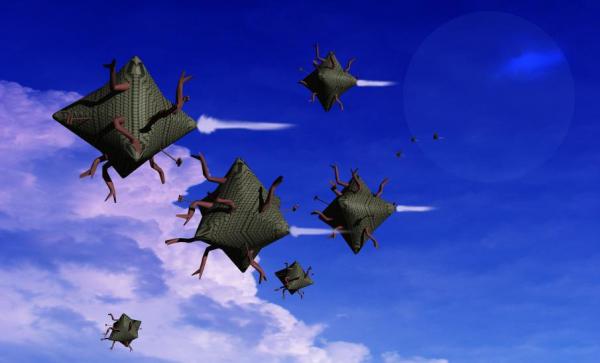BY LETTER
Screethraw, The
Alien presapient mechology which has evolved within Ishtar's Necklace | |
 Image from Steve Bowers | |
| Screethraw individuals use hydrogen peroxide jets to manouvre in the microgravity environment of Ishtar's Necklace | |
Evolution
Several million years ago, a phylum of small eusocial animals (retroactively named Thrawites) in the water/peroxide lakes evolved the ability to construct of "free colonies" constructed from the remains of foglets from other lifeforms and filled with the water/peroxide solution that allowed them to survive outside of the lakes and colonise other lakes. Over time these colony structures became increasingly complex, gaining mobility, complex feedback loops and sensory apparatus. They diversified to fill a variety of ecological niches, creating a whole phylum of mobile colony organisms - though a single species of Thrawite might construct many different types of mobile colony depending on its environment.The Screethraw are one such species of mobile colony that were constructed for long journeys between lakes, adopting a life of social scavenging en route. The complexities of such a lifestyle had pushed them into presapience by the time Terragens arrives at the Necklace.
Provolution
The Screethraw were provolved between 7620 and 7650 by a joint research team of Corvids and Nebs in Ishtar's Necklace. Though the inital provolves were provolved merely out of interest, later individuals were provolved with the intention of becoming diplomats and explorers. The initial and later provolved subclades were initially seperate, but cross breeding over the centuries has eliminated such distinctions and led to a single clade of provolved Screethraw.Bodies
The Screethraw bodyplan has roughly octahedral symmetry, with a rigid outer shell containing various limbs and sensory organs (the primary senses are sight and echolocation). The entire shell can serve as a phased optical array for camoflage and communication. The interior contains a foam of inactive foglets and is filled with the water/peroxide solution of the lakes in which the Thrawites live. Since a hole in the shell could lead to the individual bleeding out very quickly, the interior is divided into eight primary segments (following the octahedral symmetry) and numerous secondary segments.Locomotion is achieved via jets of boiling water/peroxide. If near a luminaire, a Screethraw can deploy large concave mirrors to focus the light onto its jet organs. If there is insufficient light, metabolic processes can be pushed into use instead. The mirrors can also be deployed as a defensive mechanism.
To feed, a Screethraw extends a limb into a lake or another colony organism and injects Thrawites, which will then hunt and return with foglets and water/peroxide to replenish diminished stocks.
The nervous system is dual, containing a fast optical component built into the colony itself, and a slower chemical component using complex molecules passed between Thrawites. The latter persists after death (with Thrawites retaining memories and personality fragments encoded in macromolecules), allowing Screethraw partial access to the memories of their ancestors.
Lifespan and reproduction
A Screethraw is just one stage in the lifecycle of the Thrawite swarm. They begin life being constructed in a lake by the swarm at the start of a journey and naturally end it being deconstructed at the destination lake. In lakes, the swarm will increase its population, interact with other swarms sexually, and eventually construct new Screethraw to travel elsewhere. Since Screethraw intelligence is contained partially within the Thrawite swarm, knowledge and personality is passed down lines of ancestry, albeit in a fragmented and distorted form.In theory, a Screethraw is immortal. However, ending ones life by settling down at an appropriate destination viewed as far more desirable than wandering forever.
Psychology
Screethraw tend to view life as a journey. Though this was literally true prior to their provolution, the sophont Screethraw view it as much more metaphorical. There has been extensive thought (often alongside Zerzavec social philosophers) on how best to understand the ideal journey and the ideal destination. The idea of a Good Death, where one has achieved one's aims and dissolves one's individuality into the pool of concepts for future generations, holds much power in the Screethraw mind.During their life, Screethraw are not prone to intuitive or creative leaps to the same degree humans are, strongly trusting experience as it occurs. However, between lives - when the Thrawite swarms live in lakes - concepts may mix in very odd ways, and a newly constructed Screethraw may come into existence with a number of highly original ideas and perspective, even though it may have difficulty forming new ones during life.
The influence of of the old diplomat subclade is still evident. Screethraw often tend to seek consensus, and many take a great pleasure in trying to get disparate groups to cooperate fairly. The few Screethraw who have left the Necklace are often found in association with empaths in the Communion of Worlds .
Related Articles
- Carina Cycler Union
- Carina Rush
- Carina-Vela Outer Volumes - Text by M. Alan Kazlev
Large region of space in the outer volumes, not affiliated with any of the main empires. The Andian Mission today remains a highly regarded support organization here. - Ishtar's Necklace
- Mechology, Mechosystem
- Zerzavec Commune
Appears in Topics
Development Notes
Text by Liam Jones
Initially published on 06 June 2011.
Initially published on 06 June 2011.






